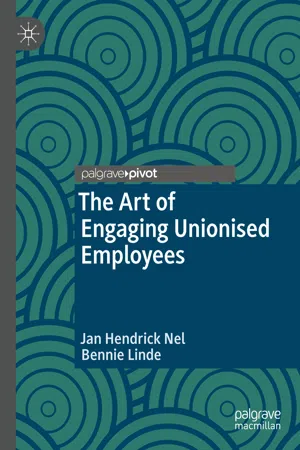Organisations are increasingly challenged to develop strategies to manage their human resources in difficult times, and one of the strategies proposed is embracing employee engagement (CIPD 2012). Employee engagement has become one of the most popular topics in management and the past decade has seen an explosion of research and heightened interest in the concept (Saks and Gruman 2014). Employee engagement proposes a reciprocal employment relationship between employers and employees, creating a mutually beneficial relationship that is a key factor for an organisation’s success, sustained competitive advantage and profitability (Saks and Gruman 2014).
The meaning of engagement might be easy to recognise in practice, but difficult to define and no widely accepted definition of engagement is currently in use (Saks and Gruman 2014; Schaufeli 2013). Engagement has been plagued by disagreement about its nature, since it was conceptualised by Kahn (1990), due to its overlap with other traditional concepts (Schaufeli 2013). The most evident overlap is with job-related attitudes, job behaviour and behavioural intentions, health and well-being, and personality traits (Schaufeli 2013).
Whittington et al. (2017) mention that researchers have described engagement as the conditions that lead to engagement, while others suggest that engagement is a personality trait and some view engagement as a state of motivation. The state approach to engagement, according to Whittington et al. (2017), reflects Kahn’s (1990) conceptualisation of engagement as “the harnessing of organisation members’ selves to their work roles: in engagement, people employ and express themselves physically, cognitively, emotionally and mentally during role performance” (p. 694).
Kahn’s (1990) conceptual work was the first to provide a foundation for the theoretical development of employee engagement. His further quests for understanding of the self-in-role process and the roles people occupy at work led to Kahn (1990) creating the term “engagement”. Kahn (1990) defined personal engagement as “the harnessing of organisation members’ selves to their work roles: in engagement, people employ and express themselves physically, cognitively, emotionally and mentally during role performance” (Kahn 1990, p. 694).
It seems that organisations believe that by managing a range of variables, known as antecedents of engagement, they can effectively manage the consequences of engagement and increase the engagement levels of its employees (Saks and Gruman 2014). Crawford et al. (2014) are of the opinion that the majority of the antecedents reflects the three psychological conditions identified by Kahn (1990) in his foundational theory, namely meaningfulness, safety and availability. The theme underlying Kahn’s (1990) research is that the individuals’ perception of the organisation, job and personal characteristics affects the experience of the three psychological conditions, which in turn guide the individuals’ decisions to engage more completely in their work roles (Crawford et al. 2014).
The consequences of high engagement levels are promoted to be what most organisations are pursuing (Bailey et al. 2015). High levels of engagement can lead to enhanced employee performance, and in turn higher profitability, revenue generation and organisational growth (Christian et al. 2011; Rich et al. 2010; Macey and Schneider 2008; Holbeche and Springett 2003; Harter et al. 2002; Wollard and Shuck 2011). Engagement and employee retention have emerged as a leading concern for organisations and those that actively enhance employee engagement will accomplish something that their competitors will find difficult to replicate (Kumar and Swetha 2011). Employee engagement has the potential to enhance both individual well-being and organisational performance, circumventing the traditional trade-offs and tension that exists between employer and employees within the human resource and industrial relations domains (Truss et al. 2013).
Although engagement has become increasingly mainstream in management over the past decade, it has been reported that engagement is on the decline worldwide and that there is a deepening disengagement among employees (Saks 2006). According to Gallup (2014), as cited in Bersin (2015), disengagement is a worldwide trend and that only 13% of employees were “highly” engaged and that 26% were “actively” disengaged. This trend validates concerns about the levels of disengagement, as disengaged employees display counterproductive workplace behaviour that impacts negatively on business outcomes (Whittington et al. 2017).
Research of Donais (2010) and Tyler (2009) suggests that unionised employees are less engaged than their non-union counterparts are. According to Crabtree (2006), a study that was published in the Gallup Management Journal shows that 26% of union employees and 35% of non-union employees engaged, that 50% of union employees and 50% of union employees are disengaged and that 23% of union employees and 15% on non-union employees are actively disengaged. Gallup, according to Crabtreee (2006, p. 3), defines engaged employees as “employees who work with a passion and feel a profound connection to their company, that they drive innovation and move the organisation forward”. Disengaged employees, on the other hand, are essentially “checked out, they sleepwalk through their workday, putting time, but not energy or passion into their work”. Actively disengaged employees aren’t just unhappy at work; they are busy acting out their unhappiness. Every day, these workers undermine what their engaged co-workers accomplish.
Employees often join unions in an attempt to increase satisfaction, but never achieve the same satisfaction leve...
